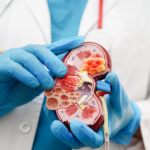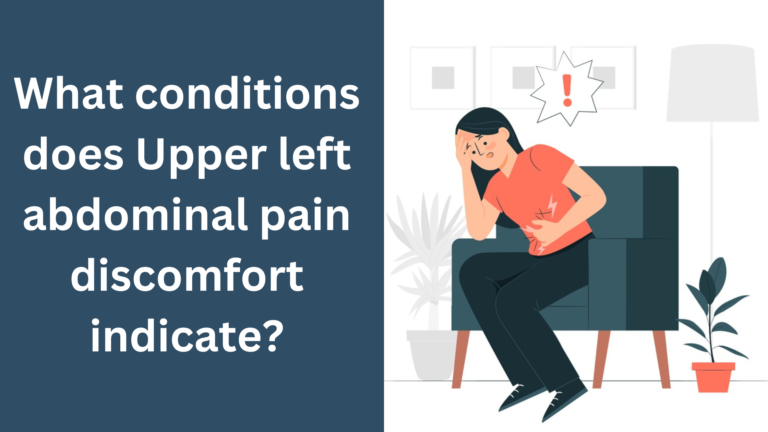Noticing blood in your stool can be alarming. Whether it’s bright red, dark, or mixed in with your stool, it’s a sign that something within your digestive system may need attention. While not always serious, it’s crucial to understand potential causes, recognize symptoms, and know when to seek medical help. Let’s break it all down step by step.
What Does Blood in Stool Look Like?
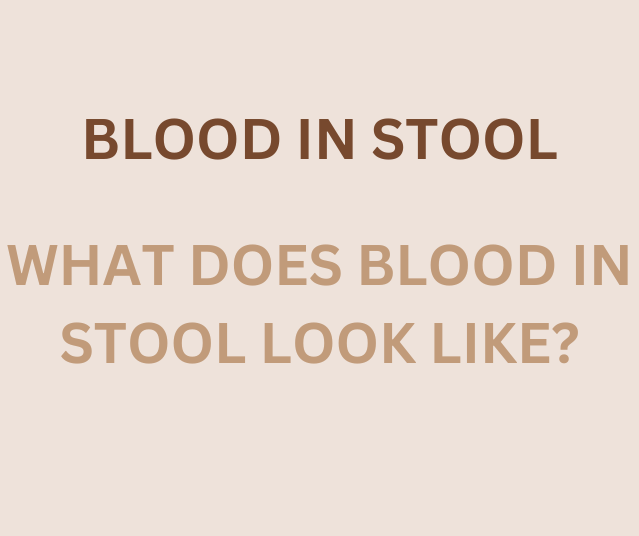
Recognizing the appearance of blood in stool is essential for understanding its cause and severity. The presence of blood may vary depending on where it originates in your digestive tract:
- Bright Red Blood: Usually indicates bleeding in the lower gastrointestinal (GI) tract, such as the rectum or anus.
- Dark, Tarry Stool (Melena): Suggests bleeding higher up in the digestive tract, such as the stomach or small intestine, where blood is partially digested.
- Streaks of Blood on Toilet Paper: Often a sign of hemorrhoids or anal fissures.
Paying attention to the color, consistency, and frequency of the blood can help your healthcare provider diagnose the root issue accurately.
Common Causes of Blood in Stool
Several conditions can cause blood in stool, ranging from mild to severe:
1. Hemorrhoids
- Swollen blood vessels in the rectum or anus
- Can cause bright red blood, especially after bowel movements
- Often accompanied by itching or pain
2. Anal Fissures
- Small tears in the anal lining
- Common with constipation or passing hard stools
- Causes sharp pain and bright red blood
3. Diverticulosis
- Small pouches in the colon wall that can bleed
- Usually painless but results in significant bleeding
4. Inflammatory Bowel Disease (IBD)
- Includes Crohn’s disease and ulcerative colitis
- Symptoms include abdominal pain, diarrhea, and blood in stool
5. Peptic Ulcers
- Sores in the stomach lining or small intestine
- Can cause dark stools due to digested blood
6. Colorectal Polyps or Cancer
- Growths in the colon that may bleed
- Often accompanied by changes in bowel habits or unexplained weight loss
When Should You Be Concerned?
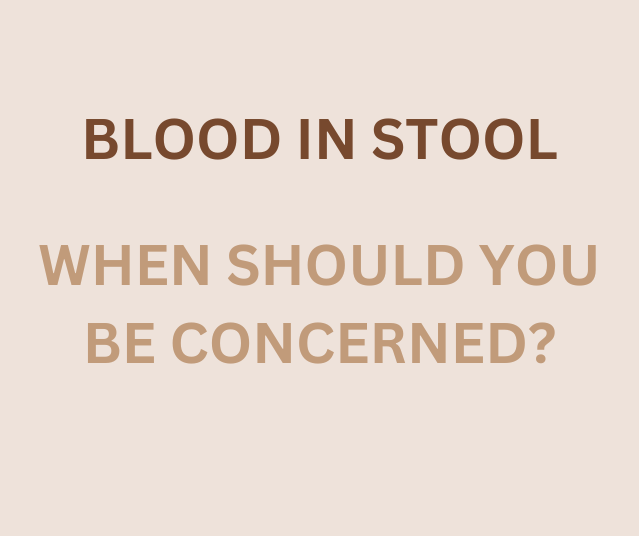
While minor rectal bleeding can be harmless, there are situations when you should seek immediate medical attention:
- Persistent Bleeding: Blood appears consistently in multiple bowel movements.
- Accompanying Symptoms: Such as severe abdominal pain, vomiting blood, or dizziness.
- Significant Blood Loss: Causes weakness, fatigue, or pale skin.
- Family History: If colorectal cancer or IBD runs in your family.
Diagnosing Blood in Stool
To determine the cause, your doctor may perform several diagnostic tests:
- Physical Examination: Includes a rectal exam to check for hemorrhoids or fissures.
- Stool Tests: Detect blood and infections.
- Colonoscopy: A detailed view of the colon to identify bleeding sources or polyps.
- Imaging Tests: Such as a CT scan to examine internal organs.
What to Do If You Spot Blood in Stool
1. Don’t Panic
Most causes of blood in stool are not life-threatening. Stay calm and monitor your symptoms.
2. Document Details
- Color and amount of blood
- Frequency of occurrence
- Associated symptoms (e.g., pain, diarrhea)
3. Adjust Your Diet
- Increase fiber intake to ease bowel movements.
- Drink plenty of water to prevent constipation.
4. Try Over-the-Counter Solutions
For conditions like hemorrhoids, topical treatments or sitz baths can provide relief.
5. Consult a Doctor
If symptoms persist or worsen, seek professional medical advice.
Treatment Options
The treatment depends on the underlying cause:
Hemorrhoids and Anal Fissures
- Fiber supplements and stool softeners
- Topical creams to reduce swelling and pain
IBD
- Medications to reduce inflammation
- Dietary adjustments and sometimes surgery
Polyps or Cancer
- Removal during a colonoscopy
- Chemotherapy, radiation, or surgery for advanced cases
Peptic Ulcers
- Proton pump inhibitors to reduce stomach acid
- Antibiotics if caused by H. pylori bacteria
Preventing Blood in Stool: 7 Healthy Lifestyle Changes
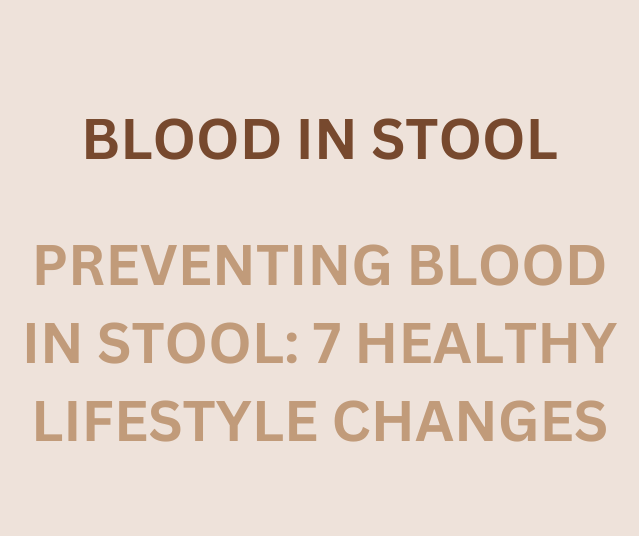
1. Eat a High-Fiber Diet
A diet rich in fiber is one of the simplest and most effective ways to prevent blood in stool. Fiber softens stools, making them easier to pass, which reduces the risk of constipation—a common cause of hemorrhoids and anal fissures.
How to Increase Fiber in Your Diet:
- Whole Grains: Opt for brown rice, oatmeal, and whole wheat bread instead of refined grains.
- Fruits and Vegetables: Include fibrous options like apples, carrots, broccoli, and spinach.
- Legumes: Lentils, chickpeas, and beans are excellent sources of both soluble and insoluble fiber.
Tip: Gradually increase your fiber intake to prevent bloating and gas, and pair it with adequate hydration.
2. Stay Hydrated
Dehydration can lead to hard stools, increasing the risk of straining during bowel movements. Drinking enough water keeps your digestive system functioning smoothly and reduces the chances of bleeding due to constipation.
Hydration Tips for Digestive Health:
- Drink at least 8–10 glasses of water daily.
- Incorporate water-rich foods like cucumbers, watermelon, and oranges.
- Limit diuretics like caffeine and alcohol, which can dehydrate the body.
Pro Tip: Start your day with a glass of lukewarm water to kickstart your metabolism and promote bowel regularity.
3. Maintain a Healthy Weight
Carrying excess weight, especially around your abdomen, puts added pressure on the pelvic area. This can worsen conditions like hemorrhoids, which are a common cause of rectal bleeding. A balanced weight-management plan can help reduce this risk.
Healthy Weight-Loss Strategies:
- Combine regular exercise with a nutritious, calorie-controlled diet.
- Focus on activities that improve digestion, such as walking or yoga.
- Avoid crash diets, as they can disrupt your gut microbiome.
Key Insight: Even losing 5–10% of your body weight can significantly improve overall digestive health.
4. Avoid Straining During Bowel Movements
Straining places undue stress on the rectal and anal veins, increasing the likelihood of developing hemorrhoids or anal fissures. To avoid this, adopt habits that promote smooth and effortless bowel movements.
Tips to Prevent Straining:
- Respond promptly to the urge to go—don’t delay.
- Use a footstool in the bathroom to mimic a natural squatting position.
- Avoid sitting on the toilet for prolonged periods, which can exacerbate pressure.
Quick Fix: If constipation persists, consult your doctor about stool softeners or fiber supplements.
5. Incorporate Regular Exercise
Physical activity isn’t just good for your heart and muscles—it’s also vital for your digestive system. Exercise helps regulate bowel movements and reduce bloating, both of which lower the risk of blood in stool.
Best Exercises for Digestive Health:
- Low-Impact Activities: Walking, swimming, and cycling improve circulation and aid digestion.
- Core Strengthening: Yoga and Pilates can enhance gut motility and reduce abdominal pressure.
- Cardio Workouts: Running or jogging encourages faster digestion but should be done in moderation.
Expert Tip: Aim for at least 30 minutes of physical activity most days of the week.
6. Schedule Regular Screenings
Regular medical check-ups and screenings, particularly colonoscopies, are essential for detecting and preventing serious conditions like colorectal cancer or polyps, which can cause blood in stool.
When to Get Screened:
- Individuals aged 50 and older should schedule routine colonoscopies.
- Start earlier if you have a family history of colorectal issues or inflammatory bowel disease (IBD).
- Discuss with your doctor if you notice persistent changes in bowel habits or unexplained bleeding.
Health Reminder: Early detection through screenings can save lives and prevent complications.
7. Avoid Harmful Habits
Certain lifestyle habits can negatively impact your digestive health, increasing the risk of rectal bleeding. Avoiding these behaviors can go a long way in prevention.
Habits to Avoid:
- Smoking: It damages blood vessels and increases the risk of colorectal cancer.
- Excessive Alcohol Consumption: Can irritate the digestive tract and cause bleeding.
- Overuse of NSAIDs: Long-term use of ibuprofen or aspirin can lead to stomach ulcers and gastrointestinal bleeding.
Action Plan: Replace harmful habits with positive ones like mindful eating, stress management, and regular exercise.
Rectal bleeding: what is it?
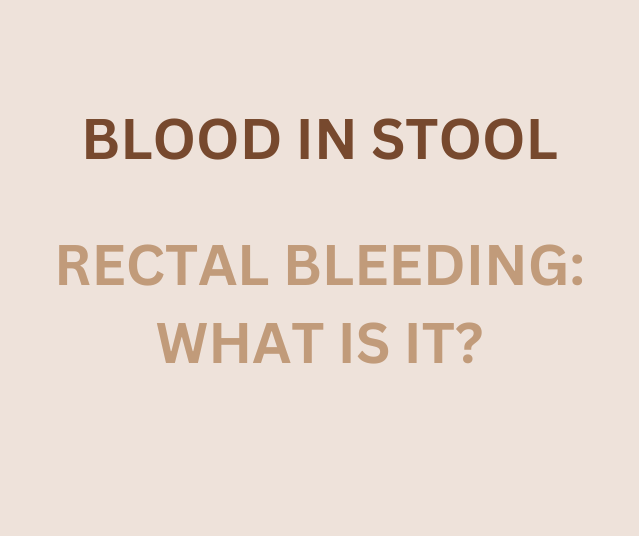
It can be frightening to look down into a toilet and find blood in your excrement. Warning signs that anything is amiss may cause your thoughts to wander. Many illnesses, some more dangerous than others, can cause rectal bleeding. Determining the reason of your rectal bleeding is crucial.
Hemorrhoids are one example of a reason that might not require treatment. Others, such as colorectal cancer, require immediate medical attention. Other potential causes include inflammatory bowel disease (IBD), ulcers, and anal fissures. Hematochezia, the medical word for rectal bleeding or blood in your feces, can be diagnosed with the assistance of a healthcare professional.
What is the appearance of rectal bleeding?
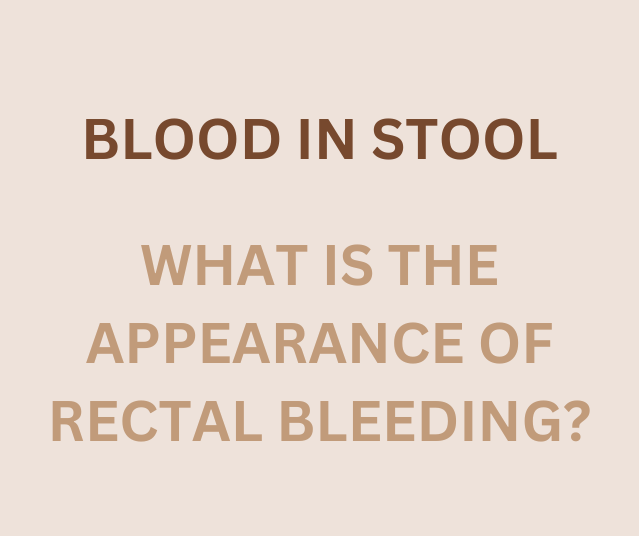
Rectal hemorrhage can manifest itself in a number of ways, such as:
When you wipe, you see fresh blood on the toilet paper.
observing blood in the toilet bowl after using the restroom. It may appear as though the water in the bowl has been painted crimson.
observing tarry black, dark crimson, or bright red feces in the toilet.
Although we refer to bleeding from the butthole (anus) as rectal bleeding, the source of the bleeding could actually be anywhere in the gastrointestinal (GI) tract. All gastrointestinal bleeding exits along the same route, which connects your stomach, small intestine, colon, rectum, and anus.
How does blood appear in stool?
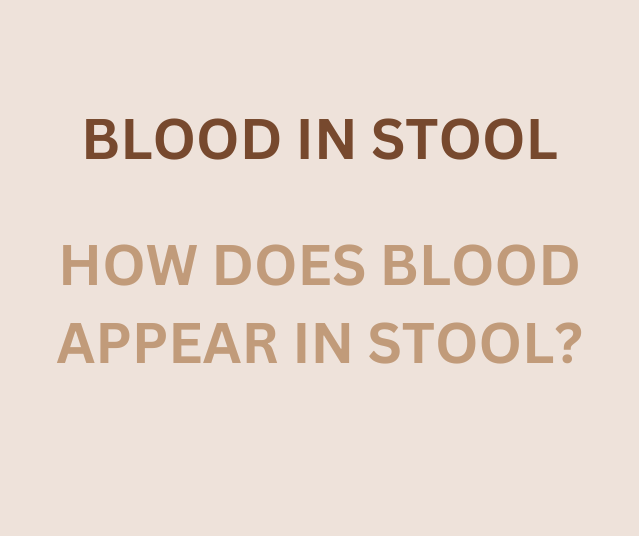
There are several ways that blood in your stool can appear. You may notice blood clots, blood and mucus mixed together, or bright red blood streaks on your droppings. Additionally, your feces may appear sticky, black, and dark. The hue of the blood you observe could provide insight into its origin:
Bright red blood in the stool typically indicates lower colon, rectum, or anus hemorrhage.
Blood that is dark crimson or maroon may indicate bleeding in the small intestine or colon.
Black stool, or melena, frequently indicates gastrointestinal bleeding, such as an ulcer.
Rectal bleeding can occasionally only be detected under a microscope and is invisible to the unaided eye. We refer to this as occult bleeding. If a fecal occult blood test is performed on a stool sample, you might find this kind of blood in your stool. It is a colorectal cancer screening test.
Do you really have blood in your stool?
It might be, but not always. Anytime you experience blood in your stool or rectal bleeding, it’s a good idea to consult your healthcare professional. Treatment may not always be necessary for mild conditions. Additionally, rectal bleeding may indicate a more serious illness that requires medical attention.
Is blood that is brilliant red in my feces worse than blood that is darker?
Because it indicates active bleeding, bright red blood in your stool may be more concerning. Darker blood typically indicates past bleeding that has stopped. Darker blood in your stool, however, can be misleading. The fact that the bleeding is coming from a higher location does not necessarily indicate that it has ceased.
It takes longer for blood from your upper gastrointestinal system to get through your body and exit your anus. It progressively becomes darker as it passes through the digestive chemicals inside. The blood is bright red and emanates from below. It can be the result of a flesh wound or something else entirely innocuous. It is less likely that an upper GI bleeding will be innocuous.
when to worry about blood in stool
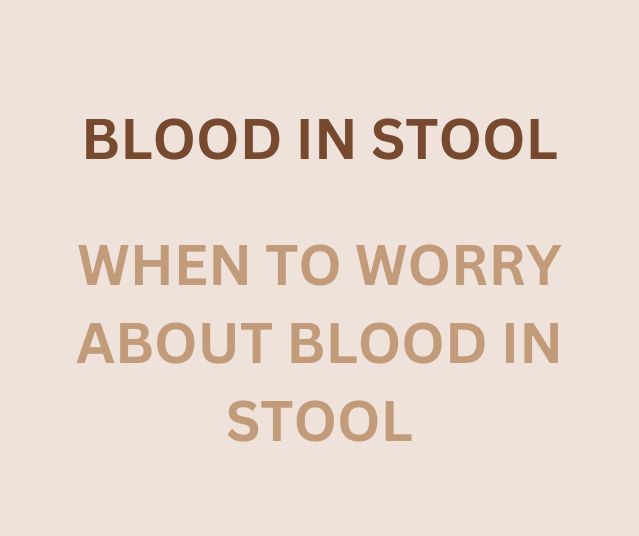
Consulting a healthcare professional about blood in your stool is always beneficial, particularly if:
You have no idea why it’s taking place. Rectal bleeding can occasionally be linked to a medical problem you are already aware you have. If you have bleeding while suffering from diarrhea, constipation, or a persistent bowel illness, you might not be overly shocked. However, it is more unexpected and worrisome if blood in your stool is the initial indication of any gastrointestinal illness.
It hurts. Pain is a constant warning sign that your body needs help. Take note of the location of the pain. It might be a new wound if it’s in your rectum or anus. Lower abdominal pain could be a sign of colitis, an inflammation of the colon’s lining that can have a variety of reasons. Your stomach may be the source of your upper abdominal ache and dark stools.
It is frequent or heavy. Anemia and, in rare instances, hypovolemic shock are among the major blood loss outcomes that are more likely to result from heavy or frequent bleeding. Seek medical attention immediately if you experience significant bleeding that occurs suddenly or if your bleeding has been continuous for a few days. Visit the emergency room (ER) if your blood pressure drops suddenly and you feel dizzy or like you’re about to faint.
It has continued for at least a week. Rectal bleeding that has persisted for a while requires treatment, even if you are not bleeding heavily or experiencing any pain. Over time, a slow bleed might nonetheless result in a sizable blood loss. More significantly, it indicates a condition that isn’t getting better. In addition to creating blood in your stool, that illness might be causing further harm.
The Importance of Early Detection
Spotting blood in stool is not something to ignore. Early detection of potential conditions like colorectal cancer significantly improves treatment outcomes. Regular screenings and a proactive approach to health can save lives.
Blood in Stool During Pregnancy: Causes and Precautions
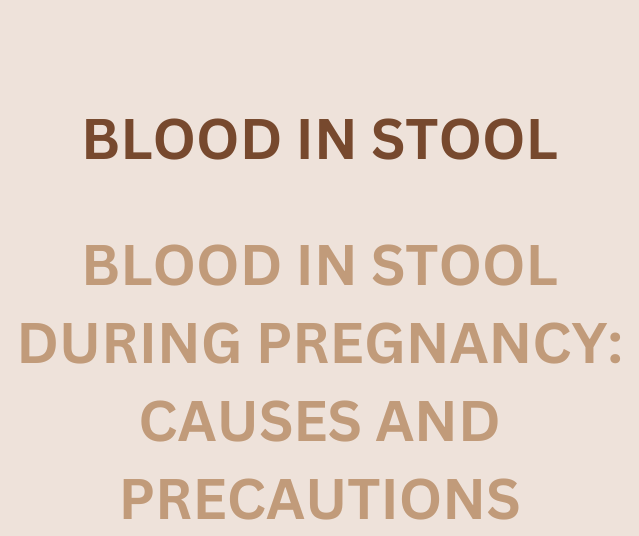
Blood in stool during pregnancy can be alarming, but it’s not always a sign of something severe. It could indicate minor issues like hemorrhoids or constipation, but it’s crucial to monitor the condition and consult a healthcare professional if it persists.
How Common Is This Issue in Pregnancy?
Blood in stool is relatively common during pregnancy, mainly due to increased pressure on the pelvic area, hormonal changes, and digestive system slowdowns. Understanding the causes can help in managing this condition effectively.
Types of Blood in Stool
Bright Red Blood
Bright red blood often signals bleeding from the lower digestive tract, like the rectum or anus. Hemorrhoids and anal fissures are common culprits.
Dark or Black Stools
Dark or tar-like stools, medically known as melena, indicate bleeding from the upper digestive tract and require immediate medical attention.
Common Causes of Blood in Stool During Pregnancy
Hemorrhoids
Hemorrhoids are swollen veins in the rectum or anus, a common side effect of pregnancy due to increased blood volume and pressure in the pelvic area. They often cause painless bleeding during bowel movements.
Constipation
Pregnancy hormones slow down digestion, leading to constipation. Straining during bowel movements can cause small tears or exacerbate hemorrhoids, resulting in blood in the stool.
Anal Fissures
Anal fissures, small cuts in the lining of the anus, can occur due to passing hard stools. They often cause bright red blood and can be accompanied by pain.
Gastrointestinal Infections
Infections from bacteria, viruses, or parasites can lead to inflammation, diarrhea, and sometimes blood in stool. These infections require medical diagnosis and treatment.
Watch Youtube Video For additional guidance:
Conclusion
Seeing blood in your stool can be unsettling, but understanding the potential causes and knowing the right steps to take can make a world of difference. By staying informed and seeking medical advice when necessary, you can address the issue effectively and regain peace of mind.
FAQs
- Is blood in stool always serious?
Not always. Conditions like hemorrhoids or anal fissures are common and treatable. However, persistent or severe bleeding warrants medical attention. - Can stress cause blood in stool?
Stress itself doesn’t directly cause blood in stool but can aggravate conditions like IBD, leading to symptoms. - How can I tell if it’s blood or food coloring?
Foods like beets or red gelatin can mimic blood. If unsure, consult a doctor or use a stool test kit. - Is rectal bleeding common in young adults?
Yes, often due to hemorrhoids or anal fissures caused by constipation. However, other causes should be ruled out. - What foods should I avoid if I have blood in stool?
Avoid spicy, fatty, or processed foods that can irritate your digestive tract. Stick to a bland, fiber-rich diet until symptoms improve.




